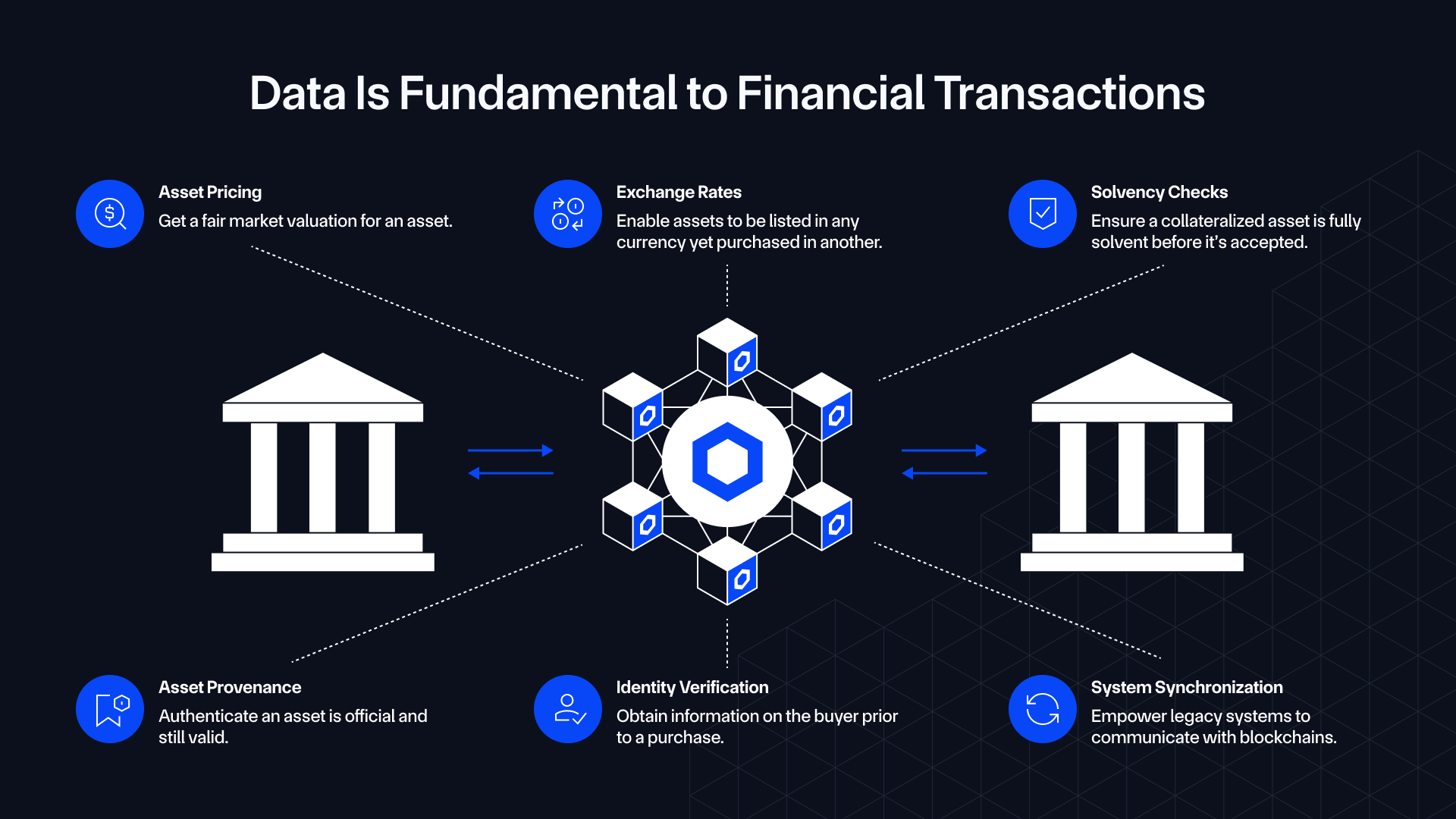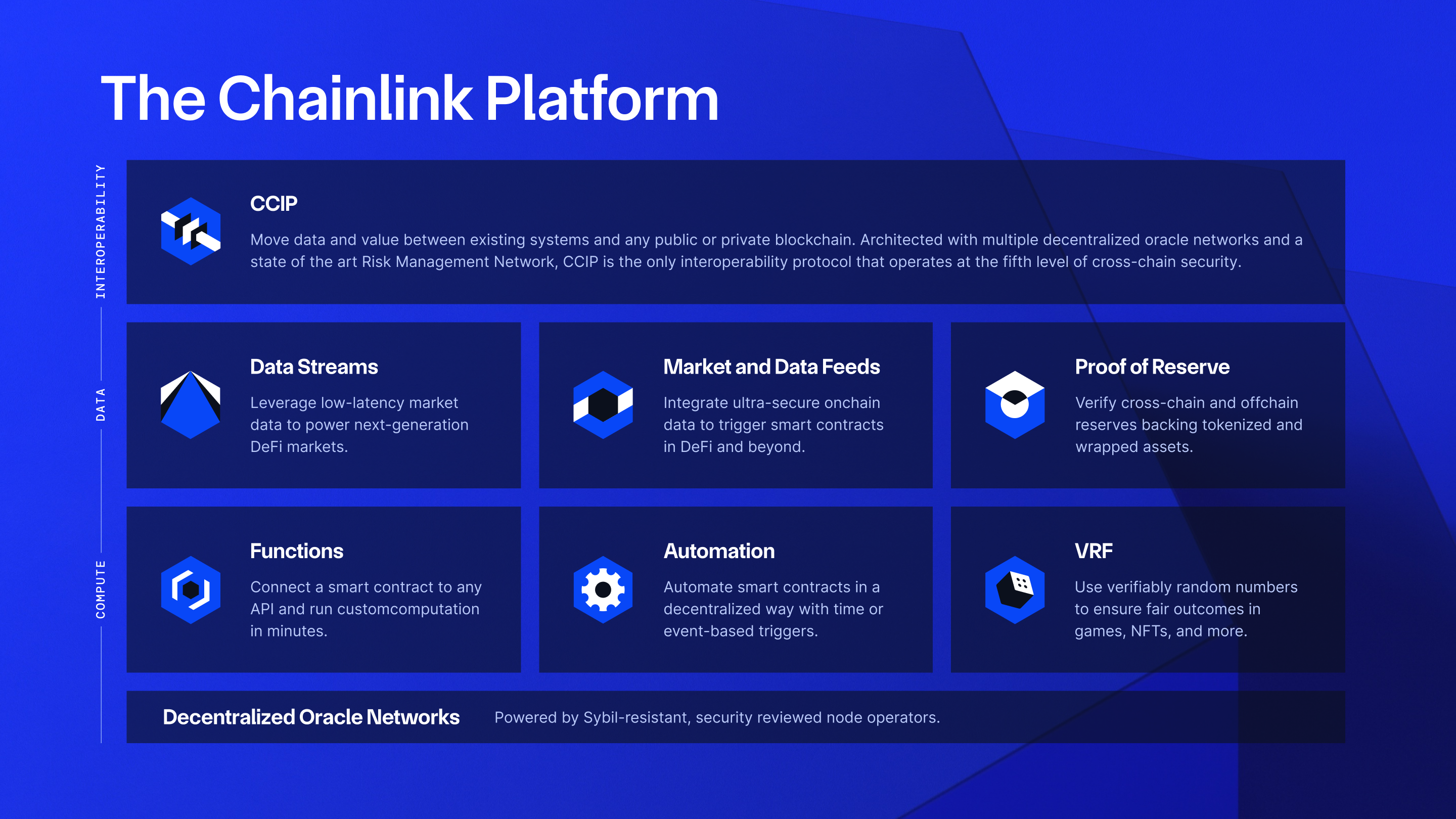What Is Chainlink? A Beginner’s Guide
Chainlink is the backbone of blockchain, the global standard connecting blockchains to real-world data, other blockchains, governments, and enterprise systems. Chainlink has enabled tens of trillions in transaction value and is being adopted by major financial institutions, national governments, and top DeFi protocols, including Swift, Euroclear, Fidelity International, UBS, Aave, GMX, Lido, and many more.
You’ve probably heard of Bitcoin and Solana or new terms like memecoins and tokenized assets. These are just a few of the many forms of blockchain technology, which Apple Co-founder Steve Wozniak has hailed as “the next major IT revolution.”
While blockchains have inherent value on their own, they find themselves at a similar moment in time to computers before the Internet transformed their role in society. That is until the introduction of Chainlink: the backbone of blockchain.
Chainlink is the missing link between blockchain and the real world, hence the name “Chain-link”. It doesn’t replace blockchains or traditional infrastructure; it unifies them. It is the single technology platform that makes advanced blockchain transactions possible, which is why many of the largest financial institutions, governments, and crypto projects are using Chainlink to unlock a whole spectrum of real-world use cases with blockchain technology.

The following blog will dive deeper into the question “what is Chainlink?”, including the problem it solves, how it solves it, and the value it unlocks for the world.
A Quick Primer on Blockchain Technology
To understand the importance of Chainlink, it’s important to first understand the value of blockchains. Blockchain is a transformative technology that fundamentally changes how the world creates, stores, trades, and manages anything of value.
What Is a Blockchain?
A blockchain is simply a digital ledger that stores data and tracks the state of it. Blockchains are mostly concerned with two forms of data: ownership and code. Blockchains track the ownership of data and assets (i.e., crypto/tokens) while code underpins applications (i.e., smart contracts) running on blockchains, which enable use cases such as payments, trading, and lending of assets. Users submit transactions to change the ownership of assets (e.g., make a payment) and developers submit transactions to upload new or update existing application code.
Why Are Blockchains Valuable?
Most blockchains operate in a decentralized and transparent manner. With decentralized blockchains, no single person or company controls the ledger. No government, corporation, or individual can unilaterally alter data, turn the network off, or censor transactions. Instead, thousands of individuals around the globe participate in the network’s operation and contribute to its security, enabling 24/7/365 availability. All of this is very different from the centralized systems that dominate a lot of the world today, with users getting unforeseen levels of transparency, fairness, and reliability.
How Are Blockchains Used?
Blockchain supports a new form of decentralized money in Bitcoin. Blockchains also power decentralized financial (DeFi) services, stablecoins, marketplaces, social media apps, and more, as well as enable anyone to launch a token and make it available to the world. In summary, you could think of blockchains as the new building block of the Internet, hence why many refer to the blockchain industry as Web3.
Ultimately, blockchains create a single format for all the world’s value, which is highly programmable and easily accessible to everyone. This technological breakthrough marks the third transformation of modern economies, which moved from paper to online to now onchain. According to the World Economic Forum, blockchain technology has the potential to disrupt up to $867 trillion worth of traditional financial markets.

The Problem: Blockchains Are Disconnected From The World
Blockchains have one major limitation—they cannot interact with anything in the outside world, such as real-world data, other blockchains, existing legacy systems, and various other technologies. This is akin to a computer without an Internet connection—useful but not able to reach its far greater potential.
This “blockchain oracle problem” exists due to the security properties of blockchains, which must operate with minimal external dependencies. Instead, communicating with the outside world requires additional infrastructure. If you want to learn more about the specifics, read the blog: The Blockchain Oracle Problem.
Without outside connectivity, blockchains are largely limited to the creation of simple tokens and peer-to-peer payments. For example, Bob sends 1 Bitcoin to his friend Alice. But what if they are on different blockchains and have different assets that need to be exchanged? Or, what if Bob and Alice are financial institutions that want to build more advanced financial applications, which must meet certain compliance and data requirements?
If blockchains are to power the future of financial markets, they need a standardized way to connect to everything in the outside world. Doing so will enable the creation of advanced transactions, which make all the use cases beyond simple payments and tokens possible.
Chainlink Unlocks Advanced Blockchain Applications
Chainlink solves the blockchain connectivity problem by providing blockchain applications with the infrastructure required to access virtually any external resource—all in a highly secure and reliable manner.

To illustrate this, let’s look at the most common problems in creating more advanced blockchain applications and how Chainlink solves them.
The Chainlink Data Standard
Problem: Most blockchain transactions and services cannot take place without access to real-world data, which exists outside blockchains (i.e., offchain).
Solution: The Chainlink Data Standard provides blockchain applications with access to any and all external data, from asset prices and proof of reserves to identity data and IoT readings. This data enables a host of blockchain applications, such as advanced trades involving exchange rates or crop insurance settlements via weather data.

The Chainlink Interoperability Standard
Problem: There are hundreds of public and private blockchains, each with distinct assets, applications, and users. Furthermore, as the cost and friction of launching a blockchain continues to drop, it is likely that even more blockchains will emerge in the future. There are also a variety of legacy systems that need to interact with blockchains. Thus, for onchain economies to thrive, data and value (e.g., tokens) must be able to seamlessly flow across blockchains and legacy systems.
Solution: The Chainlink interoperability standard, powered by the Cross-Chain Interoperability Protocol (CCIP), enables data and value to move securely across any public and private blockchain, as well as enables communication between blockchains and legacy systems, such as banks, governments, and enterprises. In doing so, Chainlink enables liquidity to move freely across onchain economies while empowering institutions to interface with blockchains without modifications to their existing systems.

The Chainlink Compute Standard
Problem: Given the countless number of offchain resources required to build an advanced blockchain application, developers need a simple, secure, and easily modifiable way to combine all these components into a single programmable workflow. Importantly, the workflow must be powered by decentralized computation to ensure that the valuable properties of blockchains are retained. In other words, Chainlink needs to do everything that blockchains can’t do, with the same high security standards.
Solution: The Chainlink compute standard, powered by the Chainlink Runtime Environment (CRE), enables developers to build advanced blockchain applications that connect any number of blockchains and offchain data and systems into a unified application. Similar to how COBOL and the Java Runtime Environment (JRE) greatly simplified web development, the CRE greatly simplifies the creation of advanced blockchain applications and enables them to run faster, cheaper, and on larger sets of data, while maintaining high security standards and meeting core business requirements such as privacy and compliance.

The Chainlink Platform
The true power of Chainlink is that it’s a platform of open standards powered by decentralized oracle networks (DONs). These standards have been applied to support a variety of different use cases, often by combining multiple standards. See the infographic below for an introduction to some of the Chainlink services powered by these standards, including CCIP, Data Streams, Data Feeds, Proof of Reserve, Functions, Automation, and VRF.

Chainlink Adoption
Banking and Capital Markets
Many of the world’s largest financial institutions, market infrastructures, and banks, such as Swift, Euroclear, UBS, SBI, ANZ, and Fidelity International, are leveraging Chainlink to develop customized, compliant, and future-proof blockchain applications and tokenized assets. Check out this repository to learn about the work Chainlink is doing within global capital markets.
Tokenized Assets
Chainlink provides the essential infrastructure and ecosystem for powering the security, data, and movement of tokenized assets. A variety of tokenized asset issuers and institutions are already leveraging Chainlink, including tokenized funds, stablecoins, and tokenized real-world assets (RWAs), to access key data like Proof of Reserves, Net Asset Value (NAV), Assets Under Management (AUM), and more. Check out this repository for the major Chainlink announcements with leading tokenization platforms, tokenized funds, and stablecoin issuers.

DeFi
Chainlink is the standard for market data in the decentralized finance (DeFi) ecosystem, such as by providing secure price feeds used to manage loans and settle derivatives or enabling proof of reserves to ensure DeFi applications can securely interact with tokenized assets. Chainlink is the most widely adopted solution by leading DeFi applications such as Aave, GMX, Compound, Lido, Ether.Fi, Pendle, and many more.

Countless Additional Use Cases
The flexibility of Chainlink means it can unlock a wide variety of use cases. One example is in artificial intelligence (AI), where Chainlink collaborated with major market infrastructures like Euroclear and Swift to showcase how Chainlink—combined with multiple large language models (LLMs)—helped solve a long-standing problem in corporate actions. Chainlink can also be used to settle insurance agreements, as well as enable fair and transparent gaming ecosystems through verifiable randomness.

The LINK Token
LINK is the native token of the Chainlink Network, used for both payments and staking. Users can pay for Chainlink services in LINK tokens or in alternative assets (e.g., gas tokens), which are automatically converted into LINK via Payment Abstraction—streamlining the payment experience. Network service providers, such as node operators and LINK Stakers, earn rewards in LINK tokens, which can then be staked to support the cryptoeconomic security of the Chainlink Network.

The Chainlink platform supports a range of billing and payment models, including:
- Usage-based payments, such as through subscription contracts or per-call models.
- Revenue-sharing agreements, such as by sharing a percentage of application revenue or recaptured MEV.
- Chainlink Build, a program where projects allocate a portion of their token supply.
- Chainlink Scale, a program where blockchain ecosystems cover Chainlink service operating costs.
Chainlink Staking adds an additional layer of cryptoeconomic security to the Chainlink Network, where LINK is staked (locked up) and can be slashed (forfeited) as a penalty if service providers fail to meet predefined performance requirements. Both node operators and community stakers play a critical role in supporting the reliability and integrity of the Chainlink Network.
Chainlink Is Inevitable
Chainlink isn’t just important—it’s foundational to the onchain future. Nearly every blockchain application needs external resources, and Chainlink is the standardized way to combine different blockchains, institutions, and various data, systems and technologies into unified applications. The opportunity is massive; so if you’re not paying attention yet, you should be.
To learn more about Chainlink, visit chain.link, subscribe to the Chainlink newsletter, and follow Chainlink on Twitter, YouTube, and Reddit.
